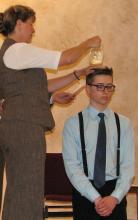As parents, you hope that you have done all that you can to nurture and encourage your children on their faith journey, and yet there is that inner voice telling you that you might not have done quite enough. Maybe you could have read more Bible stories when they were children. Maybe you should have prayed together more as a family. Maybe you should have had more in-depth discussions on being a part of the church.
This spring, when the faith exploration classes at our church were announced for any interested youth, my husband Patrick and I asked our son Tom, in Grade 11, if he wanted to be part of this group. There was some interest, but also hesitation. Would any of his friends be taking the class as well? Would he have to be baptized?
We didn’t know the answer to the first question, but we assured him that he could take the class this year and then decide if he was ready for baptism. We didn’t want to pressure him into baptism, knowing that he had to come to that decision for himself. We saw it as a good opportunity for him to learn more about what it means to be a member of Christ’s body of believers. This also led to some good discussion of our own baptism experiences.
I attended Rosthern Junior College (RJC) in Saskatchewan for grades 11 and 12, and participated in church catechism classes both of those years—in Grade 11 at Rosthern Mennonite Church, and in Grade 12 at Eigenheim (Sask.) Mennonite Church, as well as my home church, Hanley (Sask.) Mennonite, whenever I was home for a weekend. Add to that the Christian ethics and Mennonite history classes at RJC, and I think I had a pretty well-rounded understanding of what it meant to be a Mennonite Christian. However, underlying all of that was the unspoken expectation that when you were in Grade 12 you took the catechism class as part of Sunday school and then you were baptized.
Was this expectation real or had I imposed it on myself? At my home church, all four of us in Grade 12 were baptized that year. We had all participated in the catechism classes that were part of our Sunday school curriculum. Perhaps this wasn’t the best route to an adult believer’s baptism, but it did give everyone a chance to be a part of the discussion.
Every year I hear about how difficult it is to get youth together for the faith exploration class: their schedules are so full and their time so limited. If this is such a struggle, why don’t we still do this during the Sunday school hour? If everyone takes the class, will there be too much peer pressure for all to be baptized? Is choosing to join the faith exploration class the first step in choosing to be baptized? How do we best pass our faith on to our children?
I don’t really have answers to these questions, but have read some articles that show how we have changed our approach to catechism or faith exploration over the years, as the “choosing to take the class” approach has superseded the mandated “everyone takes the class” approach of my youth. Perhaps there’s a place for a bit of both, with an emphasis on Mennonite beliefs and practices in Sunday school and an opportunity to explore this further within the faith exploration sessions. Or maybe the best way to pass on our faith is by example, trusting that the way we live our lives as we seek to we follow in Christ’s footsteps testifies to what we believe.
When Tom chose to be baptized at Pentecost after attending the faith exploration classes, he stated that his faith journey had begun on the day he was born, and that his parents had taken him to church that first Sunday after and every Sunday since then.
Maybe we did enough after all.
Ev Buhr is president of Alberta Women in Mission and the office administrator at First Mennonite Church, Edmonton.





Add new comment
Canadian Mennonite invites comments and encourages constructive discussion about our content. Actual full names (first and last) are required. Comments are moderated and may be edited. They will not appear online until approved and will be posted during business hours. Some comments may be reproduced in print.